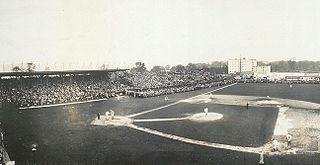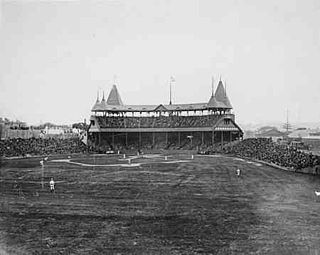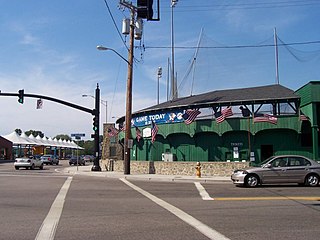
Fenway Park is a baseball stadium located in Boston, Massachusetts, less than one mile from Kenmore Square. Since 1912, it has been the ballpark of the Boston Red Sox, the city's American League baseball team, and, since 1953, its only Major League Baseball (MLB) franchise. While the stadium was built in 1912, it was substantially rebuilt in 1934, and underwent major renovations and modifications in the 21st century. It is the oldest active ballpark in MLB. Because of its age and constrained location in Boston's dense Fenway–Kenmore neighborhood, the park has many quirky features, including "The Triangle", Pesky's Pole, and the Green Monster in left field. It is the fifth-smallest among MLB ballparks by seating capacity, second-smallest by total capacity, and one of eight that cannot accommodate at least 40,000 spectators.

Wrigley Field is a stadium on the North Side of Chicago, Illinois. It is the ballpark of Major League Baseball's Chicago Cubs, one of the city's two MLB franchises. It first opened in 1914 as Weeghman Park for Charles Weeghman's Chicago Whales of the Federal League, which folded after the 1915 baseball season. The Cubs played their first home game at the park on April 20, 1916, defeating the Cincinnati Reds 7–6 in 11 innings. Chewing gum magnate William Wrigley Jr. of the Wrigley Company acquired the Cubs in 1921. It was named Cubs Park from 1920 to 1926, before being renamed Wrigley Field in 1927. The stadium currently seats 41,649 people and is the second stadium to be named Wrigley Field, as a Los Angeles ballpark with the same name opened in 1925.

The Green Monster is a popular nickname for the 37-foot-2-inch-high (11.33 m) left field wall at Fenway Park, home to the Boston Red Sox of Major League Baseball. The wall is 310 feet (94 m) from home plate and is a popular target for right-handed hitters.

Oracle Park is a baseball stadium in the SoMa district of San Francisco, California. Since 2000, it has served as the ballpark of Major League Baseball's San Francisco Giants. Previously named Pacific Bell Park, SBC Park, and AT&T Park, the stadium's current name was purchased by the Oracle Corporation in 2019.

The Polo Grounds was the name of three stadiums in Upper Manhattan, New York City, used mainly for professional baseball and American football from 1880 through 1963. The original Polo Grounds, opened in 1876 and demolished in 1889, was built for the sport of polo. Bound on the south and north by 110th and 112th streets and on the east and west by Fifth and Sixth (Lenox) avenues, just north of Central Park, it was converted to a baseball stadium when leased by the New York Metropolitans in 1880.

Ebbets Field was a Major League Baseball stadium in the Flatbush section of Brooklyn, New York. It is mainly known for having been the home of the Brooklyn Dodgers baseball team of the National League (1913–1957). It was also home to five professional football teams, including three NFL teams (1921–1948). Ebbets Field was demolished in 1960 and replaced by the Ebbets Field Apartments, the site's current occupant.

Griffith Stadium stood in Washington, D.C., from 1911 to 1965, between Georgia Avenue and 5th Street, and between W Street and Florida Avenue NW.

National League Park, commonly referred to as the Baker Bowl after 1923, was a baseball stadium and home to the Philadelphia Phillies from 1887 until 1938, and first home field of the Philadelphia Eagles from 1933 to 1935. It opened in 1887 with a capacity of 12,500, burned down in 1894, and was rebuilt in 1895 as the first ballpark constructed primarily of steel and brick, and first with a cantilevered upper deck. The ballpark's first base line ran parallel to Huntingdon Street; right field to center field parallel to North Broad Street; center field to left field parallel to Lehigh Avenue; and the third base line parallel to 15th Street. The stadium was demolished in 1950.

Crosley Field was a Major League Baseball park in Cincinnati, Ohio. It was the home field of the National League's Cincinnati Reds from 1912 through June 24, 1970, and the original Cincinnati Bengals football team, members of the second (1937) and third American Football League (1940–41). It was not the original home of the current NFL franchise of the same name: the home of those Bengals in 1968 and 1969 was nearby Nippert Stadium, located on the campus of the University of Cincinnati. Crosley Field was on an asymmetrical block bounded by Findlay Street (south), Western Avenue, Dalton Avenue (east), York Street (north) and McLean Avenue (west) in the Queensgate section of the city. Crosley has the distinction of being the first major-league park with lights for playing night games.

Hilltop Park was the nickname of a baseball park that stood in the Washington Heights neighborhood of Manhattan. It was the home of the New York Yankees of Major League Baseball from 1903 to 1912 when they were known as the "Highlanders". It was also the temporary home of the New York Giants during a two-month period in 1911 while the Polo Grounds was being rebuilt after a fire.

South End Grounds refers to any one of three baseball parks on one site in Boston, Massachusetts. They were home to the franchise that eventually became known as the Boston Braves, first in the National Association and later in the National League, from 1871 through part of the 1914 season. That stretch of 43 1/2 seasons is still the longest tenure of the Braves club at any of their various ballparks and cities since 1914.

West Side Park was the name used for two different ballparks that formerly stood in Chicago, Illinois. They were both home fields of the team now known as the Chicago Cubs of the National League. Both ballparks hosted baseball championships. The latter of the two parks, where the franchise played for nearly a quarter century, was the home of the first two world champion Cubs teams, the team that posted the best winning percentage in Major League Baseball history and won the most games in National League history (1906), the only cross-town World Series in Chicago (1906), and the immortalized Tinker to Evers to Chance double-play combo. Both ballparks were primarily constructed of wood.

Sulphur Dell, formerly known as Sulphur Spring Park and Athletic Park, was a baseball park in Nashville, Tennessee, United States. It was located just north of the Tennessee State Capitol building in the block bounded by modern-day Jackson Street, Fourth Avenue North, Harrison Street, and Fifth Avenue North. The ballpark was home to the city's minor league baseball teams from 1885 to 1963. The facility was demolished in 1969.

A ballpark, or baseball park, is a type of sports venue where baseball is played. The playing field is divided into two field sections called the infield and the outfield. The infield is an area whose dimensions are rigidly defined, and the outfield is where dimensions can vary widely from place to place. A larger ballpark may also be called a baseball stadium because it shares characteristics of other outdoor stadiums.

Borchert Field was a baseball park in Milwaukee, Wisconsin, United States. The home field for several professional baseball clubs from 1888 through 1952, it became obsolete after the construction of County Stadium in 1953 and was demolished later that year. The site is now covered by Interstate 43.

Cardines Field is a baseball stadium located at 20 America’s Cup Avenue in Newport, Rhode Island. It is believed to be one of the oldest ballparks in the United States and has been called "a small urban gem of a ballpark". The field serves as a buffer between the residential and commercial sections of an older part of Newport. The oddly shaped outfield fence and dimensions are created by the close proximity of residential housing, while the spectator side of the park is contained by America's Cup Avenue and West Marlborough Street. Originally called Basin Field, references to the field can be found as early as 1893. At that time, the property was used by local railroads as a drainage and supply basin for steam engines. Complaints from neighbors about the stagnant water and mosquitoes prompted the drainage of the basin area, permitting baseball to be played. A local historical debate continues as to whether baseball was played prior to 1900, making Cardines one of the oldest existing ballparks in the country, or if play didn't begin until 1908, the earliest documented proof of stadium construction.
Russwood Park was a stadium in Memphis, Tennessee. It was primarily used for baseball and was the home of the Memphis Chicks minor league baseball team until the spring of 1960. The ballpark was originally built in 1896 and was known as Elm Wood Park or Red Elm Park. In 1915, team owner Russell E. Garner incorporated his name into the ballpark's name. The "wood" part of the name would figure into its demise.

Clark Field was a baseball park in Austin, Texas, used primarily by the University of Texas Longhorns. The field was used from 1928 until 1974. It is considered one of the most novel ballparks ever conceived thanks to its location. There was a limestone cliff in the outfield that created havoc for outfielders and made baseball games exciting. It was replaced by UFCU Disch-Falk Field in 1975.
The history of Wrigley Field, the home of the Chicago Cubs of Major League Baseball's National League, begins well before the Cubs played their first game in that venue.
Since purchasing the Chicago Cubs baseball team and Wrigley Field in 2009, the Ricketts family have been pursuing an extensive renovation of the stadium and the surrounding venue. At its outset, the 1060 Project was projected to cost $575 million and was to be completed in four phases during consecutive off-seasons. Funding was generated from advertising revenue and increased corporate sponsorship in the form of additional signage placed in and around the stadium.
















